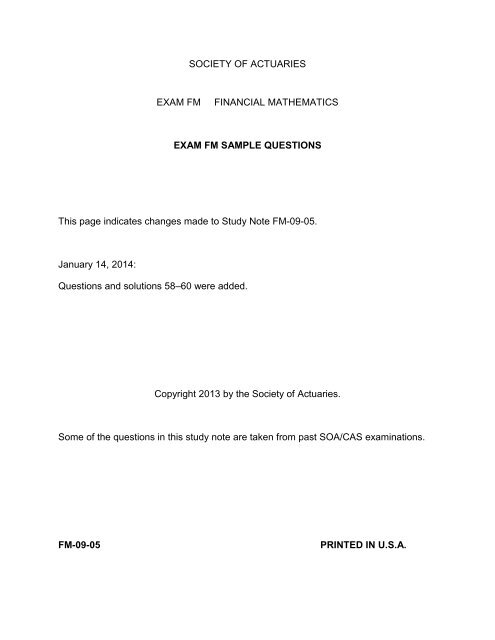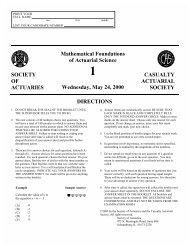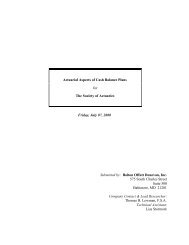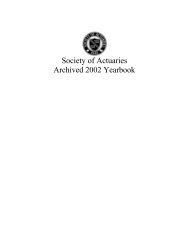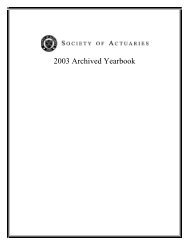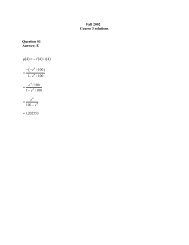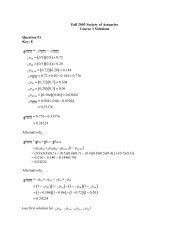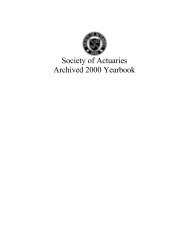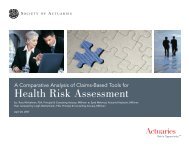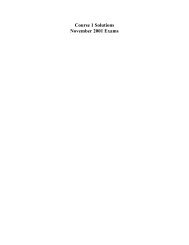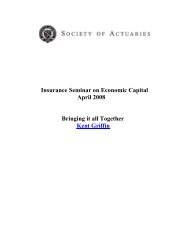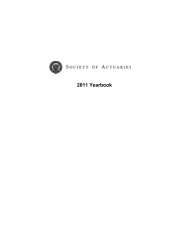Exam fm sample questions - Society of Actuaries
Exam fm sample questions - Society of Actuaries
Exam fm sample questions - Society of Actuaries
You also want an ePaper? Increase the reach of your titles
YUMPU automatically turns print PDFs into web optimized ePapers that Google loves.
SOCIETY OF ACTUARIES<br />
EXAM FM<br />
FINANCIAL MATHEMATICS<br />
EXAM FM SAMPLE QUESTIONS<br />
This page indicates changes made to Study Note FM-09-05.<br />
January 14, 2014:<br />
Questions and solutions 58–60 were added.<br />
Copyright 2013 by the <strong>Society</strong> <strong>of</strong> <strong>Actuaries</strong>.<br />
Some <strong>of</strong> the <strong>questions</strong> in this study note are taken from past SOA/CAS examinations.<br />
FM-09-05<br />
PRINTED IN U.S.A.
These <strong>questions</strong> are representative <strong>of</strong> the types <strong>of</strong> <strong>questions</strong> that might be asked <strong>of</strong><br />
candidates sitting for the new examination on Financial Mathematics (2/FM). These<br />
<strong>questions</strong> are intended to represent the depth <strong>of</strong> understanding required <strong>of</strong> candidates.<br />
The distribution <strong>of</strong> <strong>questions</strong> by topic is not intended to represent the distribution <strong>of</strong><br />
<strong>questions</strong> on future exams.<br />
11/08/04 4
1.<br />
Bruce deposits 100 into a bank account. His account is credited interest at a nominal<br />
rate <strong>of</strong> interest <strong>of</strong> 4% convertible semiannually.<br />
At the same time, Peter deposits 100 into a separate account. Peter’s account is<br />
credited interest at a force <strong>of</strong> interest <strong>of</strong> δ .<br />
After 7.25 years, the value <strong>of</strong> each account is the same.<br />
Calculate δ.<br />
(A) 0.0388<br />
(B) 0.0392<br />
(C) 0.0396<br />
(D) 0.0404<br />
(E) 0.0414<br />
11/08/04 5
2.<br />
Kathryn deposits 100 into an account at the beginning <strong>of</strong> each 4-year period for 40<br />
years. The account credits interest at an annual effective interest rate <strong>of</strong> i.<br />
The accumulated amount in the account at the end <strong>of</strong> 40 years is X, which is 5 times the<br />
accumulated amount in the account at the end <strong>of</strong> 20 years.<br />
Calculate X.<br />
(A) 4695<br />
(B) 5070<br />
(C) 5445<br />
(D) 5820<br />
(E) 6195<br />
11/08/04 6
3.<br />
Eric deposits 100 into a savings account at time 0, which pays interest at a nominal rate<br />
<strong>of</strong> i, compounded semiannually.<br />
Mike deposits 200 into a different savings account at time 0, which pays simple interest<br />
at an annual rate <strong>of</strong> i.<br />
Eric and Mike earn the same amount <strong>of</strong> interest during the last 6 months <strong>of</strong> the 8 th year.<br />
Calculate i.<br />
(A) 9.06%<br />
(B) 9.26%<br />
(C) 9.46%<br />
(D) 9.66%<br />
(E) 9.86%<br />
11/08/04 7
4.<br />
John borrows 10,000 for 10 years at an annual effective interest rate <strong>of</strong> 10%. He can<br />
repay this loan using the amortization method with payments <strong>of</strong> 1,627.45 at the end <strong>of</strong><br />
each year. Instead, John repays the 10,000 using a sinking fund that pays an annual<br />
effective interest rate <strong>of</strong> 14%. The deposits to the sinking fund are equal to 1,627.45<br />
minus the interest on the loan and are made at the end <strong>of</strong> each year for 10 years.<br />
Determine the balance in the sinking fund immediately after repayment <strong>of</strong> the loan.<br />
(A) 2,130<br />
(B) 2,180<br />
(C) 2,230<br />
(D) 2,300<br />
(E) 2,370<br />
11/08/04 8
5.<br />
An association had a fund balance <strong>of</strong> 75 on January 1 and 60 on December 31. At the<br />
end <strong>of</strong> every month during the year, the association deposited 10 from membership<br />
fees. There were withdrawals <strong>of</strong> 5 on February 28, 25 on June 30, 80 on October 15,<br />
and 35 on October 31.<br />
Calculate the dollar-weighted (money-weighted) rate <strong>of</strong> return for the year.<br />
(A) 9.0%<br />
(B) 9.5%<br />
(C) 10.0%<br />
(D) 10.5%<br />
(E) 11.0%<br />
11/08/04 9
6.<br />
A perpetuity costs 77.1 and makes annual payments at the end <strong>of</strong> the year.<br />
The perpetuity pays 1 at the end <strong>of</strong> year 2, 2 at the end <strong>of</strong> year 3, …., n at the end<br />
<strong>of</strong> year (n+1). After year (n+1), the payments remain constant at n. The annual<br />
effective interest rate is 10.5%.<br />
Calculate n.<br />
(A) 17<br />
(B) 18<br />
(C) 19<br />
(D) 20<br />
(E) 21<br />
11/08/04 10
7.<br />
1000 is deposited into Fund X, which earns an annual effective rate <strong>of</strong> 6%. At the end<br />
<strong>of</strong> each year, the interest earned plus an additional 100 is withdrawn from the fund. At<br />
the end <strong>of</strong> the tenth year, the fund is depleted.<br />
The annual withdrawals <strong>of</strong> interest and principal are deposited into Fund Y, which earns<br />
an annual effective rate <strong>of</strong> 9%.<br />
Determine the accumulated value <strong>of</strong> Fund Y at the end <strong>of</strong> year 10.<br />
(A) 1519<br />
(B) 1819<br />
(C) 2085<br />
(D) 2273<br />
(E) 2431<br />
11/08/04 11
8.<br />
You are given the following table <strong>of</strong> interest rates:<br />
Calendar Year<br />
<strong>of</strong> Original<br />
Investment Investment Year Rates (in %)<br />
i 1<br />
y<br />
i 2<br />
y<br />
i 3<br />
y<br />
i 4<br />
y<br />
i 5<br />
y<br />
Portfolio<br />
Rates<br />
(in %)<br />
i y+5<br />
y<br />
1992 8.25 8.25 8.4 8.5 8.5 8.35<br />
1993 8.5 8.7 8.75 8.9 9.0 8.6<br />
1994 9.0 9.0 9.1 9.1 9.2 8.85<br />
1995 9.0 9.1 9.2 9.3 9.4 9.1<br />
1996 9.25 9.35 9.5 9.55 9.6 9.35<br />
1997 9.5 9.5 9.6 9.7 9.7<br />
1998 10.0 10.0 9.9 9.8<br />
1999 10.0 9.8 9.7<br />
2000 9.5 9.5<br />
2001 9.0<br />
A person deposits 1000 on January 1, 1997. Let the following be the accumulated value <strong>of</strong> the<br />
1000 on January 1, 2000:<br />
Determine the ranking <strong>of</strong> P, Q, and R.<br />
(A) P> Q><br />
R<br />
(B) P> R><br />
Q<br />
(C) Q> P><br />
R<br />
(D) R > P><br />
Q<br />
(E) R > Q><br />
P<br />
P: under the investment year method<br />
Q: under the portfolio yield method<br />
R: where the balance is withdrawn at the end <strong>of</strong> every<br />
year and is reinvested at the new money rate<br />
11/08/04 12
9.<br />
A 20-year loan <strong>of</strong> 1000 is repaid with payments at the end <strong>of</strong> each year.<br />
Each <strong>of</strong> the first ten payments equals 150% <strong>of</strong> the amount <strong>of</strong> interest due. Each <strong>of</strong> the<br />
last ten payments is X.<br />
The lender charges interest at an annual effective rate <strong>of</strong> 10%.<br />
Calculate X.<br />
(A) 32<br />
(B) 57<br />
(C) 70<br />
(D) 97<br />
(E) 117<br />
11/08/04 13
10.<br />
A 10,000 par value 10-year bond with 8% annual coupons is bought at a premium<br />
to yield an annual effective rate <strong>of</strong> 6%.<br />
Calculate the interest portion <strong>of</strong> the 7 th coupon.<br />
(A) 632<br />
(B) 642<br />
(C) 651<br />
(D) 660<br />
(E) 667<br />
11/08/04 14
11.<br />
A perpetuity-immediate pays 100 per year. Immediately after the fifth payment, the perpetuity is<br />
exchanged for a 25-year annuity-immediate that will pay X at the end <strong>of</strong> the first year. Each<br />
subsequent annual payment will be 8% greater than the preceding payment.<br />
The annual effective rate <strong>of</strong> interest is 8%.<br />
Calculate X.<br />
(A) 54<br />
(B) 64<br />
(C) 74<br />
(D) 84<br />
(E) 94<br />
11/08/04 15
12.<br />
Jeff deposits 10 into a fund today and 20 fifteen years later. Interest is credited at a<br />
nominal discount rate <strong>of</strong> d compounded quarterly for the first 10 years, and at a nominal<br />
interest rate <strong>of</strong> 6% compounded semiannually thereafter. The accumulated balance in<br />
the fund at the end <strong>of</strong> 30 years is 100.<br />
Calculate d.<br />
(A) 4.33%<br />
(B) 4.43%<br />
(C) 4.53%<br />
(D) 4.63%<br />
(E) 4.73%<br />
11/08/04 16
13.<br />
Ernie makes deposits <strong>of</strong> 100 at time 0, and X at time 3. The fund grows at a force <strong>of</strong> interest<br />
2<br />
t<br />
δ<br />
t<br />
= , t > 0.<br />
100<br />
The amount <strong>of</strong> interest earned from time 3 to time 6 is also X.<br />
Calculate X.<br />
(A) 385<br />
(B) 485<br />
(C) 585<br />
(D) 685<br />
(E) 785<br />
11/08/04 17
14.<br />
Mike buys a perpetuity-immediate with varying annual payments. During the first 5<br />
years, the payment is constant and equal to 10. Beginning in year 6, the payments start<br />
to increase. For year 6 and all future years, the current year’s payment is K% larger<br />
than the previous year’s payment.<br />
At an annual effective interest rate <strong>of</strong> 9.2%, the perpetuity has a present value <strong>of</strong><br />
167.50.<br />
Calculate K, given K < 9.2.<br />
(A) 4.0<br />
(B) 4.2<br />
(C) 4.4<br />
(D) 4.6<br />
(E) 4.8<br />
11/08/04 18
15.<br />
A 10-year loan <strong>of</strong> 2000 is to be repaid with payments at the end <strong>of</strong> each year. It can be repaid<br />
under the following two options:<br />
(i) Equal annual payments at an annual effective rate <strong>of</strong> 8.07%.<br />
(ii)<br />
Installments <strong>of</strong> 200 each year plus interest on the unpaid balance at an annual effective<br />
rate <strong>of</strong> i.<br />
The sum <strong>of</strong> the payments under option (i) equals the sum <strong>of</strong> the payments under option (ii).<br />
Determine i.<br />
(A) 8.75%<br />
(B) 9.00%<br />
(C) 9.25%<br />
(D) 9.50%<br />
(E) 9.75%<br />
11/08/04 19
16.<br />
A loan is amortized over five years with monthly payments at a nominal interest rate <strong>of</strong> 9%<br />
compounded monthly. The first payment is 1000 and is to be paid one month from the date <strong>of</strong><br />
the loan. Each succeeding monthly payment will be 2% lower than the prior payment.<br />
Calculate the outstanding loan balance immediately after the 40 th payment is made.<br />
(A) 6751<br />
(B) 6889<br />
(C) 6941<br />
(D) 7030<br />
(E) 7344<br />
11/08/04 20
17.<br />
To accumulate 8000 at the end <strong>of</strong> 3n years, deposits <strong>of</strong> 98 are made at the end <strong>of</strong> each <strong>of</strong> the first<br />
n years and 196 at the end <strong>of</strong> each <strong>of</strong> the next 2n years.<br />
The annual effective rate <strong>of</strong> interest is i. You are given (l + i) n = 2.0.<br />
Determine i.<br />
(A) 11.25%<br />
(B) 11.75%<br />
(C) 12.25%<br />
(D) 12.75%<br />
(E) 13.25%<br />
11/08/04 21
18.<br />
Olga buys a 5-year increasing annuity for X.<br />
Olga will receive 2 at the end <strong>of</strong> the first month, 4 at the end <strong>of</strong> the second month, and for each<br />
month thereafter the payment increases by 2.<br />
The nominal interest rate is 9% convertible quarterly.<br />
Calculate X.<br />
(A) 2680<br />
(B) 2730<br />
(C) 2780<br />
(D) 2830<br />
(E) 2880<br />
11/08/04 22
19.<br />
You are given the following information about the activity in two different investment<br />
accounts:<br />
Account K<br />
Fund value Activity<br />
Date before activity Deposit Withdrawal<br />
January 1, 1999 100.0<br />
July 1, 1999 125.0 X<br />
October 1, 1999 110.0 2X<br />
December 31, 1999 125.0<br />
Account L<br />
Fund value Activity<br />
Date before activity Deposit Withdrawal<br />
January 1, 1999 100.0<br />
July 1, 1999 125.0 X<br />
December 31, 1999 105.8<br />
During 1999, the dollar-weighted (money-weighted) return for investment account K<br />
equals the time-weighted return for investment account L, which equals i.<br />
Calculate i.<br />
(A) 10%<br />
(B) 12%<br />
(C) 15%<br />
11/08/04 23
(D) 18%<br />
(E) 20%<br />
11/08/04 24
20.<br />
David can receive one <strong>of</strong> the following two payment streams:<br />
(i)<br />
100 at time 0, 200 at time n, and 300 at time 2n<br />
(ii) 600 at time 10<br />
At an annual effective interest rate <strong>of</strong> i, the present values <strong>of</strong> the two streams are equal.<br />
Given v n = 0.76, determine i.<br />
(A) 3.5%<br />
(B) 4.0%<br />
(C) 4.5%<br />
(D) 5.0%<br />
(E) 5.5%<br />
11/08/04 25
21.<br />
Payments are made to an account at a continuous rate <strong>of</strong> (8k + tk), where 0≤t<br />
≤ 10 .<br />
Interest is credited at a force <strong>of</strong> interest δ t = 1<br />
8 + t<br />
.<br />
After 10 years, the account is worth 20,000.<br />
Calculate k.<br />
(A) 111<br />
(B) 116<br />
(C) 121<br />
(D) 126<br />
(E) 131<br />
11/08/04 26
22.<br />
You have decided to invest in Bond X, an n-year bond with semi-annual coupons and the<br />
following characteristics:<br />
• Par value is 1000.<br />
• The ratio <strong>of</strong> the semi-annual coupon rate to the desired semi-annual yield rate, r i<br />
, is 1.03125.<br />
• The present value <strong>of</strong> the redemption value is 381.50.<br />
Given v n = 0.5889, what is the price <strong>of</strong> bond X?<br />
(A) 1019<br />
(B) 1029<br />
(C) 1050<br />
(D) 1055<br />
(E) 1072<br />
11/08/04 27
23.<br />
Project P requires an investment <strong>of</strong> 4000 at time 0. The investment pays 2000 at time 1 and 4000<br />
at time 2.<br />
Project Q requires an investment <strong>of</strong> X at time 2. The investment pays 2000 at time 0 and 4000 at<br />
time 1.<br />
The net present values <strong>of</strong> the two projects are equal at an interest rate <strong>of</strong> 10%.<br />
Calculate X.<br />
(A) 5400<br />
(B) 5420<br />
(C) 5440<br />
(D) 5460<br />
(E) 5480<br />
11/08/04 28
24.<br />
A 20-year loan <strong>of</strong> 20,000 may be repaid under the following two methods:<br />
i) amortization method with equal annual payments at an annual effective<br />
rate <strong>of</strong> 6.5%<br />
ii)<br />
sinking fund method in which the lender receives an annual effective<br />
rate <strong>of</strong> 8% and the sinking fund earns an annual effective rate <strong>of</strong> j<br />
Both methods require a payment <strong>of</strong> X to be made at the end <strong>of</strong> each year for 20 years.<br />
Calculate j.<br />
(A) j ≤ 6.5%<br />
(B) 6.5% < j ≤ 8.0%<br />
(C) 8.0% < j ≤ 10.0%<br />
(D) 10.0% < j ≤ 12.0%<br />
(E) j > 12.0%<br />
11/08/04 29
25.<br />
A perpetuity-immediate pays X per year. Brian receives the first n payments, Colleen receives<br />
the next n payments, and Jeff receives the remaining payments. Brian's share <strong>of</strong> the present<br />
value <strong>of</strong> the original perpetuity is 40%, and Jeff's share is K.<br />
Calculate K.<br />
(A) 24%<br />
(B) 28%<br />
(C) 32%<br />
(D) 36%<br />
(E) 40%<br />
11/08/04 30
26.<br />
Seth, Janice, and Lori each borrow 5000 for five years at a nominal interest rate <strong>of</strong> 12%,<br />
compounded semi-annually.<br />
Seth has interest accumulated over the five years and pays all the interest and principal in a lump<br />
sum at the end <strong>of</strong> five years.<br />
Janice pays interest at the end <strong>of</strong> every six-month period as it accrues and the principal at the end<br />
<strong>of</strong> five years.<br />
Lori repays her loan with 10 level payments at the end <strong>of</strong> every six-month period.<br />
Calculate the total amount <strong>of</strong> interest paid on all three loans.<br />
(A) 8718<br />
(B) 8728<br />
(C) 8738<br />
(D) 8748<br />
(E) 8758<br />
11/08/04 31
11/08/04 32
27.<br />
Bruce and Robbie each open up new bank accounts at time 0. Bruce deposits 100 into his bank<br />
account, and Robbie deposits 50 into his. Each account earns the same annual effective interest<br />
rate.<br />
The amount <strong>of</strong> interest earned in Bruce's account during the 11th year is equal to X. The amount<br />
<strong>of</strong> interest earned in Robbie's account during the 17th year is also equal to X.<br />
Calculate X.<br />
(A) 28.0<br />
(B) 31.3<br />
(C) 34.6<br />
(D) 36.7<br />
(E) 38.9<br />
11/08/04 33
28.<br />
Ron is repaying a loan with payments <strong>of</strong> 1 at the end <strong>of</strong> each year for n years. The amount <strong>of</strong><br />
interest paid in period t plus the amount <strong>of</strong> principal repaid in period t + 1 equals X.<br />
Calculate X.<br />
(A) 1 +<br />
v<br />
i<br />
n−t<br />
(B) 1 +<br />
v<br />
d<br />
n−t<br />
(C)<br />
1 + v n−t i<br />
(D)<br />
(E)<br />
1 + v n−t d<br />
1 + v n−t<br />
11/08/04 34
29.<br />
At an annual effective interest rate <strong>of</strong> i, i > 0%, the present value <strong>of</strong> a perpetuity paying `10 at the<br />
end <strong>of</strong> each 3-year period, with the first payment at the end <strong>of</strong> year 3, is 32.<br />
At the same annual effective rate <strong>of</strong> i, the present value <strong>of</strong> a perpetuity paying 1 at the end <strong>of</strong><br />
each 4-month period, with first payment at the end <strong>of</strong> 4 months, is X.<br />
Calculate X.<br />
(A) 31.6<br />
(B) 32.6<br />
(C) 33.6<br />
(D) 34.6<br />
(E) 35.6<br />
11/08/04 35
30.<br />
As <strong>of</strong> 12/31/03, an insurance company has a known obligation to pay $1,000,000 on<br />
12/31/2007. To fund this liability, the company immediately purchases 4-year 5%<br />
annual coupon bonds totaling $822,703 <strong>of</strong> par value. The company anticipates<br />
reinvestment interest rates to remain constant at 5% through 12/31/07. The maturity<br />
value <strong>of</strong> the bond equals the par value.<br />
Under the following reinvestment interest rate movement scenarios effective 1/1/2004,<br />
what best describes the insurance company’s pr<strong>of</strong>it or (loss) as <strong>of</strong> 12/31/2007 after the<br />
liability is paid?<br />
Interest<br />
Rates Drop<br />
Interest Rates<br />
Increase by ½%<br />
by ½%<br />
(A) +6,606 +11,147<br />
(B) (14,757) +14,418<br />
(C) (18,911) +19,185<br />
(D) (1,313) +1,323<br />
11/08/04 36
(E) Breakeven Breakeven<br />
11/08/04 37
31.<br />
An insurance company has an obligation to pay the medical costs for a claimant.<br />
Average annual claims costs today are $5,000, and medical inflation is expected to be<br />
7% per year. The claimant is expected to live an additional 20 years.<br />
Claim payments are made at yearly intervals, with the first claim payment to be made<br />
one year from today.<br />
Find the present value <strong>of</strong> the obligation if the annual interest rate is 5%.<br />
(A) 87,932<br />
(B) 102,514<br />
(C) 114,611<br />
(D) 122,634<br />
(E) Cannot be determined<br />
11/08/04 38
32.<br />
An investor pays $100,000 today for a 4-year investment that returns cash flows <strong>of</strong><br />
$60,000 at the end <strong>of</strong> each <strong>of</strong> years 3 and 4. The cash flows can be reinvested at 4.0%<br />
per annum effective.<br />
If the rate <strong>of</strong> interest at which the investment is to be valued is 5.0%, what is the net<br />
present value <strong>of</strong> this investment today?<br />
(A) -1398<br />
(B) -699<br />
(C) 699<br />
(D) 1398<br />
(E) 2,629<br />
11/08/04 39
33.<br />
You are given the following information with respect to a bond:<br />
par amount: 1000<br />
term to maturity<br />
3 years<br />
annual coupon rate 6% payable annually<br />
Term<br />
Annual Spot Interest<br />
Rates<br />
1 7%<br />
2 8%<br />
3 9%<br />
Calculate the value <strong>of</strong> the bond.<br />
(A) 906<br />
(B) 926<br />
(C) 930<br />
(D) 950<br />
(E) 1000<br />
11/08/04 40
11/08/04 41
34.<br />
You are given the following information with respect to a bond:<br />
par amount: 1000<br />
term to maturity<br />
3 years<br />
annual coupon rate 6% payable annually<br />
Term<br />
Annual Spot Interest<br />
Rates<br />
1 7%<br />
2 8%<br />
3 9%<br />
Calculate the annual effective yield rate for the bond if the bond is sold at a price equal<br />
to its value.<br />
(A) 8.1%<br />
(B) 8.3%<br />
(C) 8.5%<br />
(D) 8.7%<br />
11/08/04 42
(E) 8.9%<br />
11/08/04 43
35.<br />
The current price <strong>of</strong> an annual coupon bond is 100. The derivative <strong>of</strong> the price <strong>of</strong> the<br />
bond with respect to the yield to maturity is -700. The yield to maturity is an annual<br />
effective rate <strong>of</strong> 8%.<br />
Calculate the duration <strong>of</strong> the bond.<br />
(A) 7.00<br />
(B) 7.49<br />
(C) 7.56<br />
(D) 7.69<br />
(E) 8.00<br />
11/08/04 44
36.<br />
Calculate the duration <strong>of</strong> a common stock that pays dividends at the end <strong>of</strong> each year into<br />
perpetuity. Assume that the dividend is constant, and that the effective rate <strong>of</strong> interest is 10%.<br />
(A) 7<br />
(B) 9<br />
(C) 11<br />
(D) 19<br />
(E) 27<br />
11/08/04 45
37.<br />
Calculate the duration <strong>of</strong> a common stock that pays dividends at the end <strong>of</strong> each year<br />
into perpetuity. Assume that the dividend increases by 2% each year and that the<br />
effective rate <strong>of</strong> interest is 5%.<br />
(A) 27<br />
(B) 35<br />
(C) 44<br />
(D) 52<br />
(E) 58<br />
11/08/04 46
38. – 44. skipped<br />
11/08/04 52
45.<br />
You are given the following information about an investment account:<br />
Date<br />
Value Immediately<br />
Before Deposit<br />
Deposit<br />
January 1 10<br />
July 1 12 X<br />
December<br />
X<br />
31<br />
Over the year, the time-weighted return is 0%, and the dollar-weighted (moneyweighted)<br />
return is Y.<br />
Calculate Y.<br />
(A) -25%<br />
(B) -10%<br />
(C) 0%<br />
(D) 10%<br />
11/08/04 53
(E) 25%<br />
11/08/04 54
46.<br />
Seth borrows X for four years at an annual effective interest rate <strong>of</strong> 8%, to be repaid<br />
with equal payments at the end <strong>of</strong> each year. The outstanding loan balance at the end<br />
<strong>of</strong> the third year is 559.12.<br />
Calculate the principal repaid in the first payment.<br />
(A) 444<br />
(B) 454<br />
(C) 464<br />
(D) 474<br />
(E) 484<br />
11/08/04 55
47.<br />
Bill buys a 10-year 1000 par value 6% bond with semi-annual coupons. The price<br />
assumes a nominal yield <strong>of</strong> 6%, compounded semi-annually.<br />
As Bill receives each coupon payment, he immediately puts the money into an account<br />
earning interest at an annual effective rate <strong>of</strong> i.<br />
At the end <strong>of</strong> 10 years, immediately after Bill receives the final coupon payment and the<br />
redemption value <strong>of</strong> the bond, Bill has earned an annual effective yield <strong>of</strong> 7% on his<br />
investment in the bond.<br />
Calculate i.<br />
(A) 9.50%<br />
(B) 9.75%<br />
(C) 10.00%<br />
(D) 10.25%<br />
(E) 10.50%<br />
11/08/04 56
48.<br />
A man turns 40 today and wishes to provide supplemental retirement income <strong>of</strong> 3000 at<br />
the beginning <strong>of</strong> each month starting on his 65th birthday. Starting today, he makes<br />
monthly contributions <strong>of</strong> X to a fund for 25 years. The fund earns a nominal rate <strong>of</strong> 8%<br />
compounded monthly.<br />
On his 65 th birthday, each 1000 <strong>of</strong> the fund will provide 9.65 <strong>of</strong> income at the beginning<br />
<strong>of</strong> each month starting immediately and continuing as long as he survives.<br />
Calculate X.<br />
(A) 324.73<br />
(B) 326.89<br />
(C) 328.12<br />
(D) 355.45<br />
(E) 450.65<br />
11/08/04 57
49.<br />
Happy and financially astute parents decide at the birth <strong>of</strong> their daughter that they will<br />
need to provide 50,000 at each <strong>of</strong> their daughter’s 18 th , 19 th , 20 th and 21 st birthdays to<br />
fund her college education. They plan to contribute X at each <strong>of</strong> their daughter’s 1 st<br />
through 17 th birthdays to fund the four 50,000 withdrawals. If they anticipate earning a<br />
constant 5% annual effective rate on their contributions, which the following equations<br />
<strong>of</strong> value can be used to determine X, assuming compound interest?<br />
1 2 17<br />
1 4<br />
(A) X [ v + v + .... v ] = 50,000[ v + ... ]<br />
. 05 .05 .05<br />
.05<br />
v.05<br />
16<br />
15<br />
1<br />
3<br />
(B) X [(1.05) + (1.05) + ...(1.05) ] = 50,000[1 + ... v ]<br />
.05<br />
17<br />
16<br />
3<br />
(C) X [(1.05) + (1.05) + ...1] = 50,000[1 + ... v ]<br />
.05<br />
17<br />
16<br />
1<br />
3<br />
(D) X [(1.05) + (1.05) + ...(1.05) ] = 50,000[1 + ... v ]<br />
.05<br />
1 17<br />
18 22<br />
(E) X [(1 + v + .... v ] = 50,000[ v + ... ]<br />
. 05 .05<br />
.05<br />
v.05<br />
11/08/04 58
50.<br />
A 1000 bond with semi-annual coupons at i (2) = 6% matures at par on October 15, 2020.<br />
The bond is purchased on June 28, 2005 to yield the investor i (2) = 7%. What is the<br />
purchase price?<br />
Assume simple interest between bond coupon dates and note that:<br />
Date<br />
Day <strong>of</strong> the Year<br />
April 15 105<br />
June 28 179<br />
October 15 288<br />
(A) 906<br />
(B) 907<br />
(C) 908<br />
(D) 919<br />
(E) 925<br />
11/08/04 59
The following information applies to <strong>questions</strong> 51 thru 53.<br />
Joe must pay liabilities <strong>of</strong> 1,000 due 6 months from now and another 1,000 due one<br />
year from now. There are two available investments:<br />
a 6-month bond with face amount <strong>of</strong> 1,000, a 8% nominal annual coupon rate<br />
convertible semiannually, and a 6% nominal annual yield rate convertible semiannually;<br />
and<br />
a one-year bond with face amount <strong>of</strong> 1,000, a 5% nominal annual coupon rate<br />
convertible semiannually, and a 7% nominal annual yield rate convertible semiannually<br />
51.<br />
How much <strong>of</strong> each bond should Joe purchase in order to exactly (absolutely) match the<br />
liabilities?<br />
Bond I<br />
Bond II<br />
(A) 1 .97561<br />
(B) .93809 1<br />
(C) .97561 .94293<br />
(D) .93809 .97561<br />
(E) .98345 .97561<br />
11/08/04 60
11/08/04 61
The following information applies to <strong>questions</strong> 51 thru 53.<br />
Joe must pay liabilities <strong>of</strong> 1,000 due 6 months from now and another 1,000 due one<br />
year from now. There are two available investments:<br />
a 6-month bond with face amount <strong>of</strong> 1,000, a 8% nominal annual coupon rate<br />
convertible semiannually, and a 6% nominal annual yield rate convertible semiannually;<br />
and<br />
a one-year bond with face amount <strong>of</strong> 1,000, a 5% nominal annual coupon rate<br />
convertible semiannually, and a 7% nominal annual yield rate convertible semiannually<br />
52.<br />
What is Joe’s total cost <strong>of</strong> purchasing the bonds required to exactly (absolutely) match<br />
the liabilities?<br />
(A) 1894<br />
(B) 1904<br />
(C) 1914<br />
(D) 1924<br />
(E) 1934<br />
11/08/04 62
The following information applies to <strong>questions</strong> 51 thru 53.<br />
Joe must pay liabilities <strong>of</strong> 1,000 due 6 months from now and another 1,000 due one<br />
year from now. There are two available investments:<br />
a 6-month bond with face amount <strong>of</strong> 1,000, a 8% nominal annual coupon rate<br />
convertible semiannually, and a 6% nominal annual yield rate convertible semiannually;<br />
and<br />
a one-year bond with face amount <strong>of</strong> 1,000, a 5% nominal annual coupon rate<br />
convertible semiannually, and a 7% nominal annual yield rate convertible semiannually<br />
53.<br />
What is the annual effective yield rate for investment in the bonds required to exactly<br />
(absolutely) match the liabilities?<br />
(A) 6.5%<br />
(B) 6.6%<br />
(C) 6.7%<br />
(D) 6.8%<br />
(E) 6.9%<br />
11/08/04 63
54.<br />
Matt purchased a 20-year par value bond with semiannual coupons at a nominal annual<br />
rate <strong>of</strong> 8% convertible semiannually at a price <strong>of</strong> 1722.25. The bond can be called at par<br />
value X on any coupon date starting at the end <strong>of</strong> year 15 after the coupon is paid. The<br />
price guarantees that Matt will receive a nominal annual rate <strong>of</strong> interest convertible<br />
semiannually <strong>of</strong> at least 6%.<br />
Calculate X.<br />
(A) 1400<br />
(B) 1420<br />
(C) 1440<br />
(D) 1460<br />
(E) 1480<br />
.<br />
11/08/04 64
55.<br />
Toby purchased a 20-year par value bond with semiannual coupons at a nominal<br />
annual rate <strong>of</strong> 8% convertible semiannually at a price <strong>of</strong> 1722.25. The bond can be<br />
called at par value 1100 on any coupon date starting at the end <strong>of</strong> year 15.<br />
What is the minimum yield that Toby could receive, expressed as a nominal annual rate<br />
<strong>of</strong> interest convertible semiannually?<br />
(A) 3.2%<br />
(B) 3.3%<br />
(C) 3.4%<br />
(D) 3.5%<br />
(E) 3.6%<br />
11/08/04 65
56.<br />
Sue purchased a 10-year par value bond with semiannual coupons at a nominal annual<br />
rate <strong>of</strong> 4% convertible semiannually at a price <strong>of</strong> 1021.50. The bond can be called at par<br />
value X on any coupon date starting at the end <strong>of</strong> year 5. The price guarantees that Sue<br />
will receive a nominal annual rate <strong>of</strong> interest convertible semiannually <strong>of</strong> at least 6%.<br />
Calculate X.<br />
(A) 1120<br />
(B) 1140<br />
(C) 1160<br />
(D) 1180<br />
(E) 1200<br />
11/08/04 66
57.<br />
Mary purchased a 10-year par value bond with semiannual coupons at a nominal<br />
annual rate <strong>of</strong> 4% convertible semiannually at a price <strong>of</strong> 1021.50. The bond can be<br />
called at par value 1100 on any coupon date starting at the end <strong>of</strong> year 5.<br />
What is the minimum yield that Mary could receive, expressed as a nominal annual rate<br />
<strong>of</strong> interest convertible semiannually?<br />
(A) 4.8%<br />
(B) 4.9%<br />
(C) 5.0%<br />
(D) 5.1%<br />
(E) 5.2%<br />
11/08/04 67
58.<br />
You are given the following information:<br />
i) The current price <strong>of</strong> stock A is 50.<br />
ii) Stock A will not pay any dividends in the next year.<br />
iii) The annual effective risk-free interest rate is 6%.<br />
iv) Each transaction costs 1.<br />
v) There are no transaction costs when the forward<br />
is settled.<br />
Based on no arbitrage, calculate the maximum price <strong>of</strong> a one-year forward.<br />
(A) 49.06<br />
(B) 50.00<br />
(C) 50.88<br />
(D) 53.00<br />
(E) 55.12
59.<br />
A liability consists <strong>of</strong> a series <strong>of</strong> 15 annual payments <strong>of</strong> 35,000 with the first payment to be made<br />
one year from now.<br />
The assets available to support this liability are five-year and ten-year zero-coupon bonds.<br />
The annual effective interest rate used to value the assets and liabilities is 6.2%. The liability has<br />
the same present value and duration as the asset portfolio.<br />
Calculate the amount invested in the five-year zero-coupon bonds.<br />
(A) 127,000<br />
(B) 167,800<br />
(C) 208,600<br />
(D) 247,900<br />
(E) 292,800
60.<br />
You are given the following information about a loan <strong>of</strong> L that is to be repaid with a series <strong>of</strong> 16<br />
annual payments:<br />
i) The first payment <strong>of</strong> 2000 is due one year from now.<br />
ii) The next seven payments are each 3% larger than the preceding payment.<br />
iii) From the 9 th to the 16 th payment, each payment will be 3% less than the<br />
preceding payment.<br />
iv) The annual effective interest rate is 7%.<br />
Calculate L.<br />
(A) 20,689<br />
(B) 20,716<br />
(C) 20,775<br />
(D) 21,147<br />
(E) 22,137


